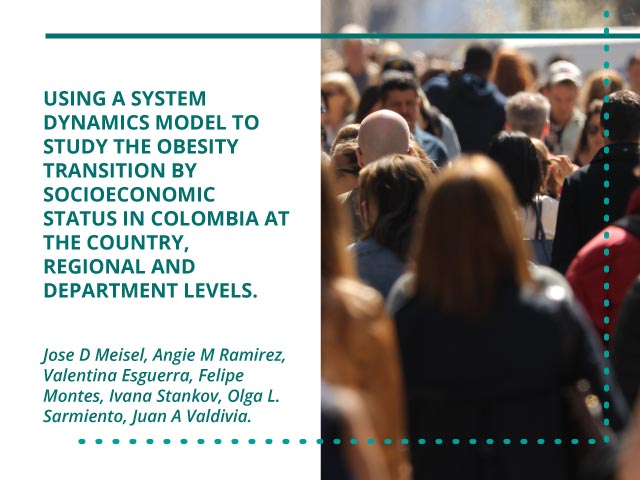Los invitamos a consultar el artículo realizado por un grupo de profesores de distintas universidades alrededor del mundo, entre los que se encuentra la profesora Olga L. Sarmiento de la Facultad de Medicina de la Universidad de los Andes, titulado "Using a system dynamics model to study the obesity transition by socioeconomic status in Colombia at the country, regional and department levels."
Abstract:
Objective: We study the obesity transition by socioeconomic status (SES), gender and age within the Colombian urban population at the country, regional and department levels.
Design: The study is informed by cross-sectional data from the 2005 and 2010 ENSIN survey. We used these data to develop a system dynamics model that simulates the dynamics of obesity by body mass index (BMI) categories, gender and SES at the country, regional and department levels from 2005 to 2030.
Participants: The sample size of the 2005 ENSIN comprised 8515 children younger than 5 years, 32 009 children and adolescents aged 5–17 years and 48 056 adults aged 18–64 years. In 2010, the corresponding numbers were 11 368, 32 524 and 64 425, respectively. Primary and secondary outcome measure The obesity prevalence ratio and prevalence rates for each BMI category.
Results: The results show, at the country level, transitions from overweight to obesity were projected to increase sharply among lower SES adults, particularly among women, suggesting that these groups will undergo an obesity transition by 2030. The model projections also indicate that the regions of Colombia are in different stages of the obesity transition. In the case of women, five out of the six regions were expected to undergo an obesity transition by SES over time. For men, only one region was expected to undergo an obesity transition. However, at the department level, trends in the burden of obesity varied. Conclusions We evidence that the Colombian population could be experiencing an obesity transition where the increase in the GDP could be related to shifts in the burden of obesity from higher to lower SES, especially in women. These patterns support the need for policy planning that considers SES and gender, at the national and subnational levels, as important determinants of overweight and obesity among adults in Colombia.
Autores:
Olga L. Sarmiento
- Facultad de Medicina de la Universidad de los Andes
Jose D. Meisel
- Universidad de Ibague
Angie M. Ramirez
- Universidad de Ibague
Valentina Esguerra
- Universidad de los Andes
Felipe Montes
- Universidad de los Andes
Ivana Stankov
- Drexel University
Juan A. Valdivia
- Universidad de Chile













